How to Grow Jackfruit: A Beginner’s Guide
- March 16, 2024
- 0 comment
Dive into the world of jackfruit farming with our guide How to Grow Jackfruit. Starting from the rainforests of India to your backyard, learn everything from seed sowing to enjoying the harvestjust of the world’s largest tree fruit, known for its distinct taste and impressive size. This guide will walk you through the process of growing Jackfruit, from seed germination to harvest.
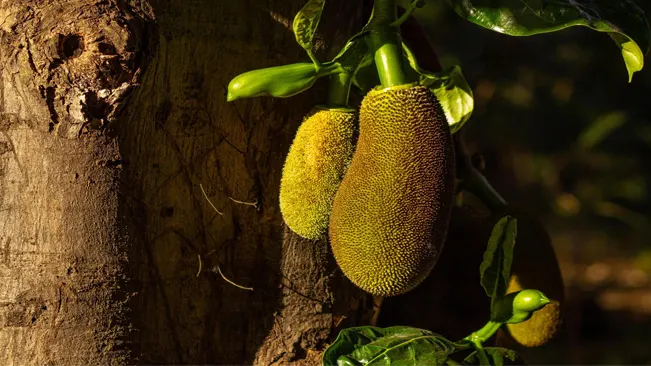
Benefits of Jackfruit
| Benefit | Description |
|---|---|
| Nutritional Value | Jackfruit is rich in vitamins (A, C, B6), minerals (potassium, magnesium, iron), and dietary fiber, supporting overall health. |
| High in Antioxidants | Contains antioxidants like carotenoids and flavonoids, which help combat oxidative stress and may reduce the risk of chronic diseases. |
| Supports Immune Health | High in vitamin C and other antioxidants, it strengthens the immune system. |
| Aids Digestion | The high fiber content promotes a healthy digestive system and can prevent constipation. |
| Helps Control Blood Sugar Levels | Jackfruit has a low glycemic index and high fiber, which helps regulate blood sugar levels. |
| Heart Health | The potassium in jackfruit can help lower blood pressure, and its antioxidants may reduce the risk of heart disease. |
| Weight Management | Being low in calories and high in fiber, it can contribute to a feeling of fullness, aiding in weight management. |
| Cancer Prevention Potential | Contains compounds like lignans, isoflavones, and saponins that may have anti-cancer properties. |
| Improves Skin and Eye Health | Vitamin A and C in jackfruit support skin health and vision. |
| Vegan Meat Substitute | The texture of young, unripe jackfruit is similar to meat, making it a popular meat substitute for vegans and vegetarians. |
List on How To Grow Jackfruit
- Choosing the Right Location
- Planting Jackfruit
- Caring for Your Jackfruit Tree
- Pest and Disease Management
- Harvesting
Choosing the Right Location
Climate Requirements
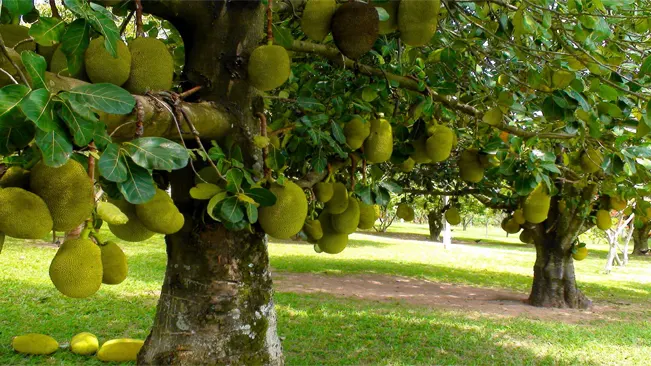
- Humidity and Temperature: Jackfruit trees thrive in high humidity and require warm temperatures throughout the year. They are not frost-tolerant, which makes them unsuitable for temperate climates. The ideal temperature range is consistently above 18°C (65°F), though they can tolerate higher temperatures well.
- Rainfall and Seasons: These trees do best in regions where there is a clear distinction between wet and dry seasons. In the wet season, they benefit from abundant rainfall, which helps in the growth and development of the fruit. During the dry season, reduced watering can help in the maturation and ripening of the fruit.
- Sunlight: Jackfruit trees need plenty of sunlight. They should be planted in a location where they can receive full sun for most of the day. This is essential for the tree’s growth and fruit production.
Soil Preferences
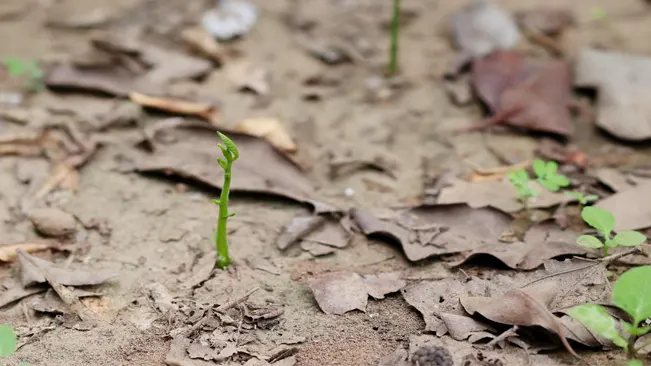
- Soil Type: While jackfruit trees prefer deep, rich loamy soil, they are quite adaptable and can grow in a variety of soil types. The key factor is good drainage. Waterlogged conditions can lead to root diseases and negatively impact the tree’s growth.
- pH Level: The soil’s pH level plays a crucial role in the health of the tree. Jackfruit trees do best in slightly acidic to neutral soil, with a pH range of 6.0 to 7.5. In soils outside this pH range, the tree might not absorb nutrients effectively, leading to poor growth and fruiting.
- Soil Depth and Fertility: Deep soil allows for extensive root growth, which is beneficial for the large size of the jackfruit tree. Adding organic matter, such as compost or well-rotted manure, can improve soil fertility, structure, and moisture retention, providing an ideal environment for the tree.
Planting Jackfruit
Planting Jackfruit from Seeds
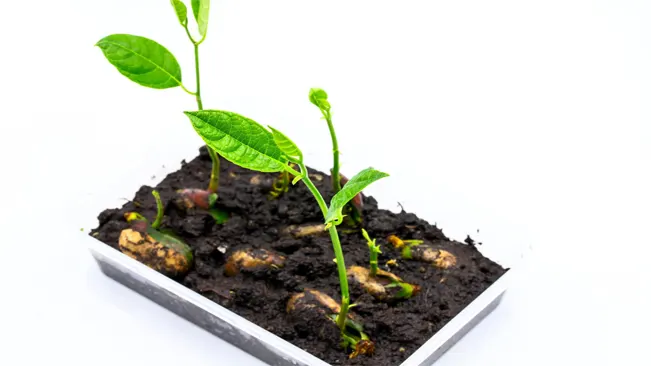
- Obtaining Seeds: The best seeds are obtained from a ripe, healthy jackfruit. Select seeds that are plump and free of cracks or damage. Freshness is key, as older seeds have a lower germination rate.
- Preparing the Soil: Choose a well-draining soil mix, ideally a combination of loam and organic compost. The soil should be nutrient-rich to support initial growth.
- Planting the Seeds: Plant the seeds about an inch deep into the soil. Space them out by a few inches if planting multiple seeds in one container. This depth ensures adequate soil coverage for root development while not being too deep to hinder sprout emergence.
- Ideal Conditions for Germination: Maintain a consistent soil moisture level, not too soggy or dry. Jackfruit seeds need warmth to germinate, so keep the soil in a warm environment, ideally between 25°C to 30°C (77°F to 86°F). You can use a greenhouse or a warm indoor spot.
- Germination Time: Germination typically occurs within 3-8 weeks. Be patient, as some seeds may take longer than others.
Planting Jackfruit from Saplings
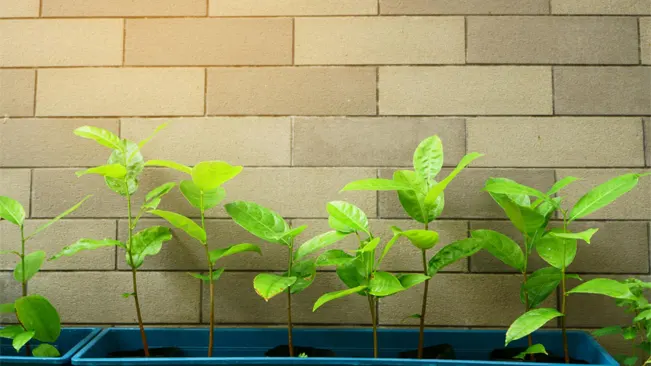
- Purchasing Saplings: It’s often easier to start with a sapling, which you can buy from a reputable nursery. Choose a healthy-looking sapling, ideally one that’s about a year old.
- Selecting the Planting Site: Jackfruit trees grow large, so pick a spacious, sunny spot in your garden. They require full sun and plenty of space for root and canopy growth.
- Preparing the Planting Hole: Dig a hole that’s twice as wide and deep as the root ball of the sapling. This gives the roots plenty of room to expand and access nutrients.
- Planting the Sapling: Carefully place the sapling in the center of the hole. Fill the hole with soil, gently compacting it to eliminate air pockets. Ensure that the base of the trunk is level with the surrounding soil surface to prevent waterlogging.
- Initial Watering: Water the sapling thoroughly after planting. This helps settle the soil around the roots and provides the necessary hydration to recover from the transplanting shock.
Caring for Your Jackfruit Tree
Watering
- Frequency and Amount: The watering needs of a Jackfruit tree vary based on the climate and soil type. In general, during the growing season and particularly in dry periods, regular watering is crucial. Young trees require more frequent watering than mature ones. The goal is to maintain moist, not waterlogged, soil.
- Monitoring Soil Moisture: To avoid overwatering, check the soil moisture by inserting your finger into the soil. If the top inch of the soil is dry, it’s time to water.
- Drip Irrigation: Consider using a drip irrigation system to deliver water directly to the roots, reducing water wastage and preventing leaf diseases that can result from overhead watering.
Fertilizing
- When to Fertilize: The best time to fertilize is during the active growing season, usually in spring and summer. Avoid fertilizing in the dormant season, as the tree won’t absorb the nutrients efficiently.
- Types of Fertilizers: Along with balanced chemical fertilizers like NPK 10-10-10, incorporating organic fertilizers like compost, manure, or fish emulsion can promote a more natural growth environment and improve soil health.
- Method of Application: Apply fertilizer evenly around the base of the tree, extending out to the drip line (the area directly corresponding to the canopy’s edge). Be careful not to place fertilizer too close to the trunk, as this can cause burn.
Pruning
- Best Time for Pruning: Pruning is best done in late winter or early spring, just before the new growth starts. This timing helps the tree heal faster and minimizes the risk of disease.
- Technique: When pruning, make clean cuts close to the branch collar (the swelling where the branch joins the trunk) without damaging it. Remove dead, diseased, or crossing branches to promote better air circulation and sunlight penetration.
- Shaping the Tree: Regular pruning helps control the size and shape of the tree, making it easier to harvest the fruit. It can also encourage more fruiting branches to develop.
Pest and Disease Management
Common pests include jackfruit borers and fruit flies. Fungal diseases like root rot and rust can also occur. Regular monitoring and using organic or chemical treatments as needed can help manage these issues.
Pest Management
- Jackfruit Borers:
- These are larvae of beetles that bore into the trunk and branches, causing significant damage.
- Management: Regular inspection of the tree for boreholes is essential. Infested parts should be removed and destroyed. Insecticides may be used, but it’s advisable to prefer eco-friendly options.
- Fruit Flies:
- Fruit flies lay eggs on the developing fruits, and the larvae feed inside, spoiling the fruit.
- Management: Use fruit fly traps or organic baits. Sanitation practices like removing fallen fruits and debris can help reduce their population.
Disease Management
- Root Rot:
- Caused by various fungi, root rot can occur due to overwatering and poor drainage.
- Symptoms: Yellowing leaves, stunted growth, and eventual death of the plant.
- Management: Ensure good drainage and avoid overwatering. Infected trees might need fungicide treatment or removal to prevent the spread.
- Rust:
- A fungal disease that causes orange or brownish spots on the leaves.
- Symptoms: Pustules on the underside of leaves, defoliation, and reduced fruit quality.
- Management: Fungicides can be effective. Removing and destroying infected leaves helps prevent the spread.
Integrated Pest and Disease Management (IPDM)
- Cultural Practices: Implementing good agricultural practices like proper spacing, pruning, and sanitation (removal of diseased and dead plant parts) can significantly reduce pest and disease incidence.
- Biological Control: Encouraging natural predators of pests, such as birds and beneficial insects, can help manage pest populations.
- Chemical Control: Use chemical treatments as a last resort, and prefer eco-friendly and organic options when available. Always follow the recommended guidelines for their use.
Harvesting
Jackfruit undergoes a significant transformation from flowering to maturity. After the flowering stage, the fruit typically takes about 3 to 8 months to fully mature. The time can vary based on climatic conditions, the variety of the jackfruit, and the tree’s health.
Signs of Maturity
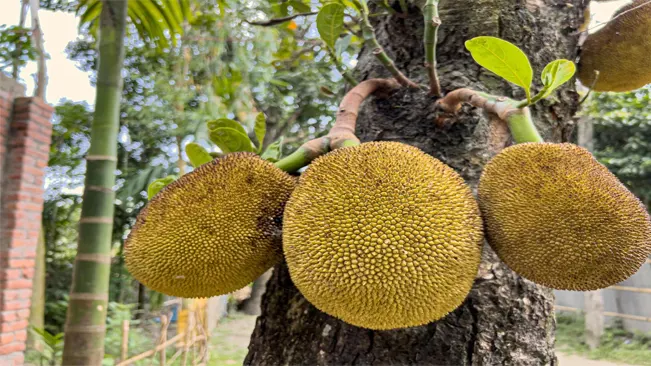
- Color Change: As the jackfruit matures, its color shifts. Initially green, the skin gradually turns to a yellowish-brown hue. This color change is a primary indicator of ripeness.
- Fragrance: One of the most noticeable signs of a ripe jackfruit is its strong, distinctive smell. When ripe, the fruit emits a sweet, fruity aroma that’s quite pronounced and can often be detected from a distance.
- Sound Test: Tapping on the fruit is a traditional method used to check its ripeness. An unripe jackfruit will give a dull, solid sound, while a ripe one sounds more hollow. This method is used because as the jackfruit ripens, its internal structure changes, affecting the sound it makes when tapped.
- Texture and Spikes: The spikes on the jackfruit’s exterior soften as it ripens. The fruit itself may feel slightly softer to the touch when it’s ready to be harvested.
Harvesting Method
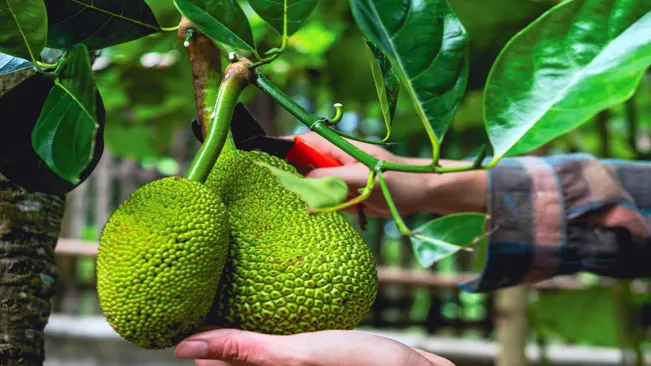
- Use of Tools: Due to its large size and sometimes sticky sap, use sharp, sturdy cutting tools like a pruning saw or large knife to cut the jackfruit from the tree. It’s advisable to wear gloves and protective clothing.
- Cutting the Stem: When harvesting, leave a portion of the stem attached to the fruit. This practice helps in handling the fruit and also prolongs its shelf life.
- Handling Sap: Jackfruit sap is sticky and can adhere to tools and skin. Applying oil to the blades of your tools and your hands can help prevent the sap from sticking.
Post-Harvest Handling

- Cleaning: After harvesting, clean the exterior of the fruit to remove any sap residue and dirt.
- Storage: If you’re not using the jackfruit immediately, store it in a cool, dry place. The fruit can be refrigerated to extend its shelf life but is best consumed when fresh.
- Preparation: When cutting open the jackfruit, oiling the knife and your hands can ease the process, as the fruit’s interior can also be quite sticky.
- Utilization: Jackfruit can be eaten fresh, or used in various culinary applications. The ripe fruit is sweet and can be used in desserts, while the unripe fruit has a neutral flavor and is often used in savory dishes as a meat substitute.
Related Post:
- How to Grow Ground Cherry: Simple Steps for Lush Growth
- How to Grow Spaghetti Squash: Your Thriving Garden Guide 2024
- How to Grow Runner Beans: A Comprehensive Guide for Bountiful Harvests
- How to Grow Jicama: Your Easy Guide to Cultivating the Mexican Yam Bean
- How to Grow Cinnamon Basil: A Beginner’s Guide to Aromatic Gardening
- How to Grow Roma Tomatoes: Expert Tips for a Lush Homegrown Harvest
- How to Grow Blackberries: Easy Steps to Grow and Nurture Your Own
Conclusion
Jackfruit trees are not only valued for their delicious fruit but also for their multiple environmental benefits, such as providing shade and improving soil quality. These hardy trees, once established, require relatively low maintenance, making them a suitable choice for both novice and experienced gardeners in suitable climates. Additionally, the versatility of jackfruit in culinary uses, ranging from ripe sweet fruit to unripe meat substitutes, adds to its appeal. Thus, cultivating a jackfruit tree offers both nutritional benefits and a satisfying gardening experience.
FAQs (Frequently Asked Questions)
- What climate is best for growing jackfruit?
- Jackfruit thrives in humid, tropical climates with a minimum temperature of 18°C (65°F). They are sensitive to frost and prefer distinct wet and dry seasons.
- Jackfruit thrives in humid, tropical climates with a minimum temperature of 18°C (65°F). They are sensitive to frost and prefer distinct wet and dry seasons.
- Can I grow jackfruit from seed?
- Yes, you can grow jackfruit from seeds. Plant fresh seeds from a ripe jackfruit in well-draining soil, keep moist and in a warm place. Germination typically occurs within 3-8 weeks.
- Yes, you can grow jackfruit from seeds. Plant fresh seeds from a ripe jackfruit in well-draining soil, keep moist and in a warm place. Germination typically occurs within 3-8 weeks.
- How long does it take for a jackfruit tree to bear fruit?
- A jackfruit tree can take 3-6 years to bear fruit, depending on the growing conditions and care.
- A jackfruit tree can take 3-6 years to bear fruit, depending on the growing conditions and care.
- What kind of soil is suitable for jackfruit trees?
- Jackfruit trees prefer deep, rich loamy soil. They can adapt to various soil types as long as they are well-draining. The ideal soil pH range is 6.0 to 7.5.
- Jackfruit trees prefer deep, rich loamy soil. They can adapt to various soil types as long as they are well-draining. The ideal soil pH range is 6.0 to 7.5.
- How much water does a jackfruit tree need?
- Jackfruit trees require regular watering, especially during the dry season. However, overwatering can lead to root rot, so it’s essential to ensure good drainage.
- Jackfruit trees require regular watering, especially during the dry season. However, overwatering can lead to root rot, so it’s essential to ensure good drainage.
- Do I need to fertilize my jackfruit tree?
- Yes, use a balanced fertilizer (like NPK 10-10-10) during the growing season. You can also add organic matter such as compost to enrich the soil.
- Yes, use a balanced fertilizer (like NPK 10-10-10) during the growing season. You can also add organic matter such as compost to enrich the soil.
- How do I protect my jackfruit tree from pests and diseases?
- Regular monitoring for pests like jackfruit borers and fruit flies, and diseases like root rot and rust is essential. Use organic or chemical treatments as needed.
- Regular monitoring for pests like jackfruit borers and fruit flies, and diseases like root rot and rust is essential. Use organic or chemical treatments as needed.
- How do I know when to harvest jackfruit?
- Harvest jackfruit when it emits a strong, pleasant smell and the outer skin turns from green to yellowish-brown. The fruit will also produce a hollow sound when tapped.
- Harvest jackfruit when it emits a strong, pleasant smell and the outer skin turns from green to yellowish-brown. The fruit will also produce a hollow sound when tapped.
- Can I grow jackfruit in a pot?
- It’s challenging to grow jackfruit in a pot due to its large size. However, dwarf varieties might be more suitable for container growing.
- It’s challenging to grow jackfruit in a pot due to its large size. However, dwarf varieties might be more suitable for container growing.
- What pruning is required for a jackfruit tree?
- Pruning is essential to maintain a manageable tree size and shape, and to remove dead or diseased branches. Pruning should be done carefully to avoid damage to the tree.

Kristine Moore
Forestry AuthorI'm Kristine Moore, a seasoned garden landscaping professional with over 30 years of experience. My extensive career has been dedicated to transforming outdoor spaces into stunning, sustainable landscapes. With a deep understanding of horticulture, design principles, and environmental stewardship, I have become a respected figure in the field, known for creating harmonious, visually appealing, and eco-friendly gardens. My commitment to excellence and continuous learning in landscaping trends and techniques has solidified my reputation as an expert in garden design and implementation.













Leave your comment